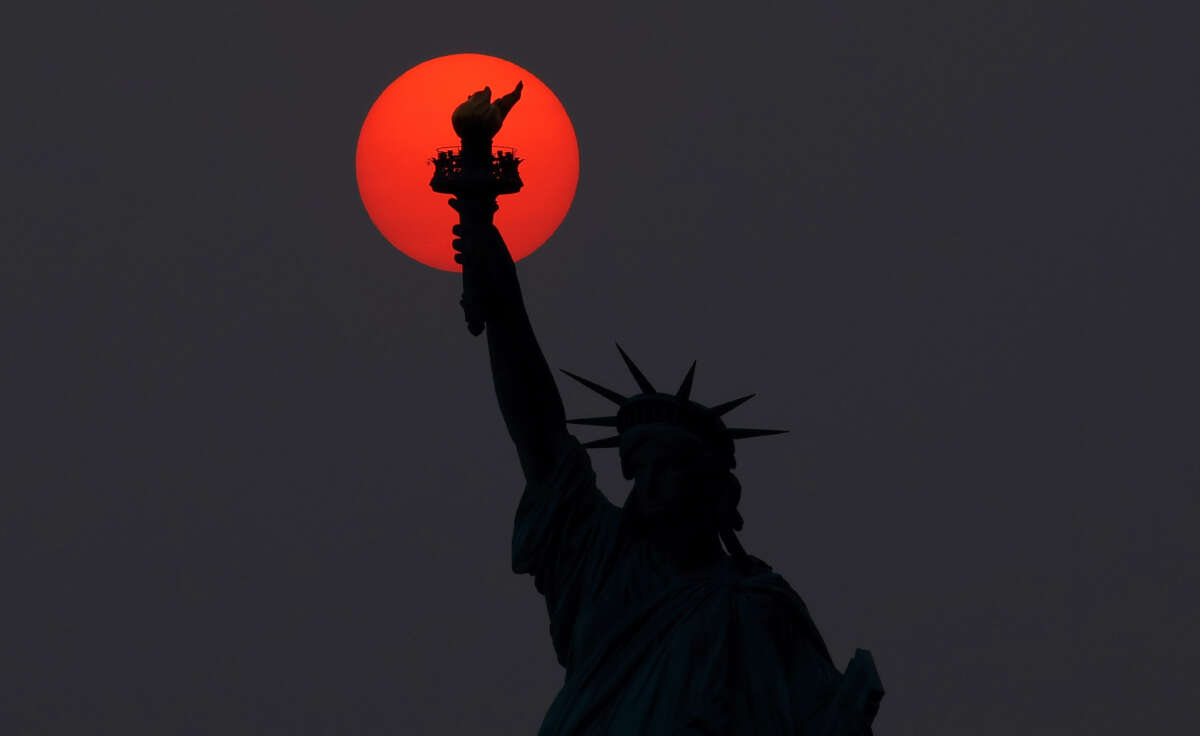In the latest sign that the climate crisis is here and already endangering people across the world, much of the eastern half of the U.S. woke up on Wednesday morning to find their homes blanketed in smoke as wildfires in Canada create apocalyptic scenes in major cities like New York.
Wildfire smoke swept across the Northeast, Midwest and South — even stretching as far west as New Mexico — on Tuesday and Wednesday, carrying with it dangerous levels of air pollution. High levels of PM2.5, the smallest level of particulate matter that is tiny enough to be absorbed into the bloodstream, caused air quality to plummet in many states, leading schools to cancel outdoor activities and cities to issue health alerts warning residents to close windows and avoid going outside.
This has led some parts of the U.S. to experience some of the worst air quality levels in the world. Briefly on Tuesday, air pollution tracking company IQAir said that New York City’s air quality was the second worst in the world, with an air quality index above 200, which is categorized as “very unhealthy”. A healthy air quality index, by contrast, is between 0 and 50.
Photos from cities like New York and Washington, D.C. showed buildings barely visible under thick layers of smoke. Some people in the thick of the smoke have reported it burning their eyes and lungs, while they are able to smell and even taste the smoke in the air.
The wildfires in Canada that are causing the smoke are unprecedented, experts say, and have been worsened significantly by the climate crisis. Many areas of Canada have been experiencing record high temperatures, adding fuel to some 200 wildfires that were burning across the country last week. Experts have said that the air pollution levels may be some of the worst on record for the affected parts of the U.S.
Latest view of Midtown, also via @Earthcam. Surreal. pic.twitter.com/P16tLle8R7
— New York Metro Weather (@nymetrowx) June 6, 2023
The climate crisis creates conditions ripe for wildfires to burn, drying out entire watersheds while causing areas to heat up drastically, especially around the Arctic. Climate experts have long pointed out that, due to changes wrought by the climate crisis, it’s not just the western U.S. and Canada that is susceptible to regular wildfires, but now also the east as the crisis flips the climate of normally wet regions entirely on its head — with more frequent droughts laying the ground for catastrophic wildfires.
Climate advocates have called for urgent action in response to the smoke event, saying that it is the decades of delay and denial on drawing down fossil fuels that have led the U.S. to this point.
“The climate crisis is here. Clouds of smoke from wildfires in Canada are clogging our airways in Boston,” wrote Sen. Ed Markey (D-Massachusetts). “And with only more extreme heat on the horizon — this is just a preview of what’s to come. We need climate action now.”
“This is not about our grandchildren anymore. This is about whether or not we can breathe air right fucking now,” wrote activist group Climate Defiance on Twitter.
At the same time, this week, Puerto Rico is experiencing a record heat wave, with a heat index of up to 125 degrees fahrenheit in some places.
Rep. Alexandria Ocasio-Cortez (D-New York) called for the passage of a Green New Deal on Tuesday. “Between NYC in wildfire smoke and [record heat] in [Puerto Rico], it bears repeating how unprepared we are for the climate crisis,” she said. “We must adapt our food systems, energy grids, infrastructure, healthcare, etc ASAP to prepare for what’s to come and catch up to what is already here.”
While the wildfire smoke choked out cities, however, Republicans in Congress sought to pass a rule on Tuesday that would place a prohibition on gas stove bans. This is the latest move in their quest to prop up the fossil fuel industry — the very industry responsible for the haze of smoke surrounding the Capitol and poisoning anyone around it.
Our most important fundraising appeal of the year
December is the most critical time of year for Truthout, because our nonprofit news is funded almost entirely by individual donations from readers like you. So before you navigate away, we ask that you take just a second to support Truthout with a tax-deductible donation.
This year is a little different. We are up against a far-reaching, wide-scale attack on press freedom coming from the Trump administration. 2025 was a year of frightening censorship, news industry corporate consolidation, and worsening financial conditions for progressive nonprofits across the board.
We can only resist Trump’s agenda by cultivating a strong base of support. The right-wing mediasphere is funded comfortably by billionaire owners and venture capitalist philanthropists. At Truthout, we have you.
We’ve set an ambitious target for our year-end campaign — a goal of $250,000 to keep up our fight against authoritarianism in 2026. Please take a meaningful action in this fight: make a one-time or monthly donation to Truthout before December 31. If you have the means, please dig deep.
